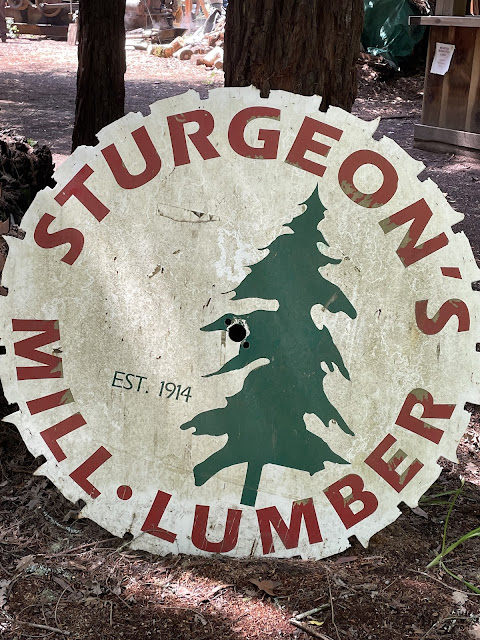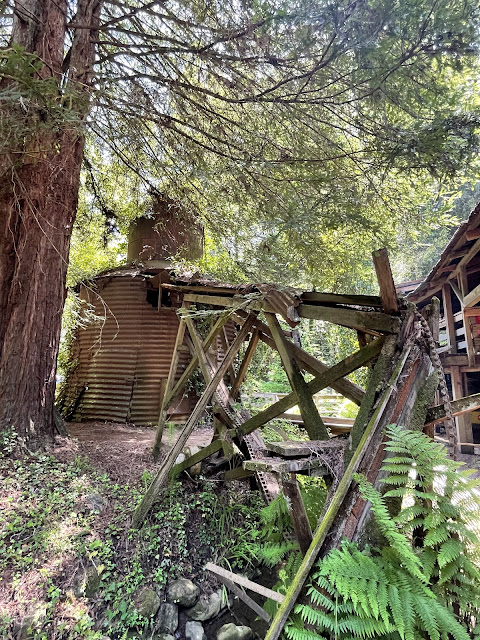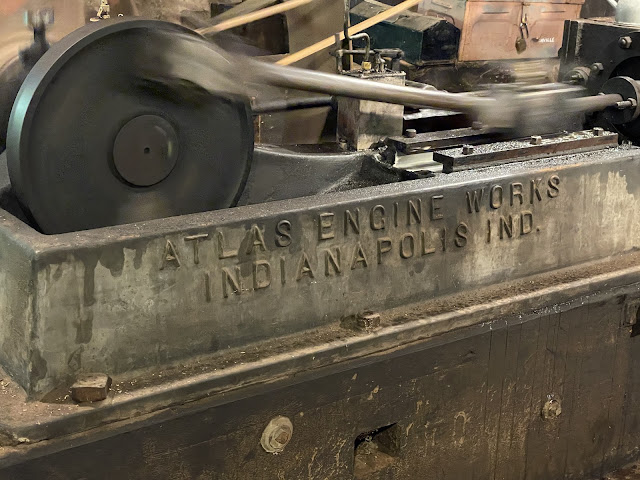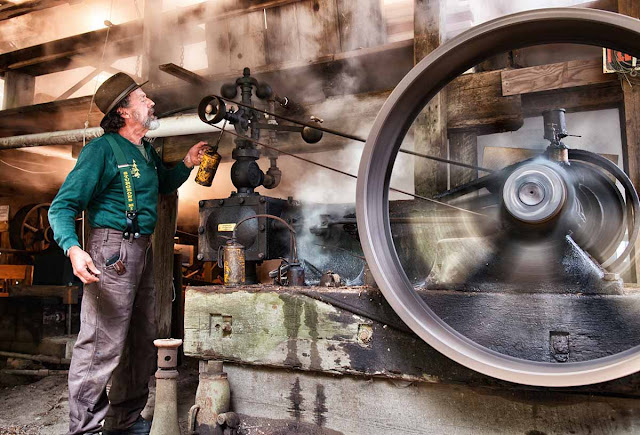Shaver Lake Mill & Flume
While camping at Shaver lake (August 2022) I visited the Museum of the Sierra at Camp Edison. They had displayed photographs and artifacts from both the Fresno Flume and Lumber Company as well as items from the Shaver Lake Lumber Company. These operations depicted the same settings for my logging railroad of the Pickering/Madera/Sugar Pine operations of the early 1900’s era.
The Shaver Lake Mill
C.B. Shaver and Lewis Swift were business partners in the Fresno Flume and Irrigation Co., late 19th Century logging operation in the Pine Ridge area of the CentralSierra. Endless stands of Sugar Pine and Yellow Pine awaited the fellar’s axe, moving the lumber from forest to valley by wagon or railroad faced insurmountable difficulties. Shaver and Swift envisioned the construction of a dam across Stephenson Creek and a wooden flume to carry rough-cut lumber 42 miles to a planing mill in Clovis. Shaver Lake was created in 1894 by building a rock and wood fill dam at right angles. Shaver managed the business operations and Swift was the mill superintendent, in charge of construction and operations at the mill. The Shaver mill operated from 1894 to 1914, when heavy winter snows severely damaged part of the flume. The old mill site lies at the bottom of today’s Shaver Lake. California Edison currently owns the lake and the surrounding forest. (The present dam is 183’ high, 2,200’ long; with a capacity of 135,000 acre feet of water.
 |
| Shaver Lake Mill 1890’s |
The Shaver Lake Flume 1892-1914
Flume Tender’s Cabin 1892-1914, mature stands of Ponderosa and Sugar pine covered the mountain slopes of Shaver Lake. The flume traveled a distance of 42 miles from the Shaver Lake sawmill pond to the planing mill in Clovis, CA.. The route was surveyed and designed by John S. Eastwood of the Big Creek Hydroelectric Project. It took 9,000,000 board feet of lumber to build the 42 mile-long flume. There were 12 small flume tender cabins constructed along the route for the flume tenders to monitor the flow of the lumber. Food and supplies were sent down the flume in flume boats, spring, summer and fall seasons. There was a phone line established for communications along the flume route. The flume was damaged by flooding, fire and heavy snows in its short lifespan.
 |
| Fresno Flume & Lumber Co. stock certificate |
Water, timber, mineral and the scenic beauty of the Sierra Nevada provided a significant economic base for early day Clovis. California was booming and lumber was needed. The San Joaquin Valley Railroad arrived in Clovis in 1891 and the flume in 1893. Both created new markets for ranchers, farmers and the lumber industry.
The rugged terrain and canyons made logging in the Sierra unprofitable until the V-flume arrived. It was an unconventional man-made “river.” The V-type flume (two flat boards joined together at right angle) was invented in 1859 by J.W. Hines.
In 1890, the Big Dry Creek Flume and Irrigation Company was formed by pioneer families Sample, Letcher, Heiskell, Miller and Davis. They built an earthen dam on Stevenson Creek, created a lake, built a box flume with a V-flume above it that would carry water and lumber from Shaver to Tollhouse. The water from the box flume would then be diverted to Big Dry Creek and sold to ranchers.
The Miller and Lux Company controlled 22,000 square miles of cattle and farmland in California, Nevada and Oregon. In 1894, it filed an injunction that prohibited the flume company from delivering water to Big Dry Creek but it was agreed that the flume could continue to ship lumber. In was not until 1908 that the name of Fresno Flume and Irrigation was changed to Fresno Flume and Lumber Company.
In 1891, the flume was sold to Frank Bullard and others from Yolo County. It was reorganized under the name Fresno Flume and Irrigation. In 1892, Michigan lumbermen, L.P. Swift and C.B. Shaver and local pioneers, Bullard, Musick, Butler and Colson purchased the project.
Shaver and his brother-in-law Swift built a sawmill adjacent to the dam. Freight wagons, pulled by 36 horses, were used to transport mill equipment up Tollhouse Road. The steepest section required heavy equipment to be moved by block and tackle. Tollhouse Road was aptly named “the beast killer.”
The first earthen dam washed out during the spring flood of 1892. It was replaced by a rock dam 60 feet high in 1893. It is still visible when Shaver Lake water level is low.
John A. Eastwood (Fresno’s first city engineer) designed the V-shaped flume. It was made of cedar planks, 16 feet long and 16 inches wide by 1 1/2 inches thick. It was assembled in units called “boxes.” A total of 320 boxes equaled one mile.
Trestles (90 feet high at Musick Crossing) supported the flume. Adventurous men were lowered in baskets as they crossed canyons and cliffs to drill holes into the rock to secure the trestle. Once the trestle was in place, the crew built the V-shaped trough and a 16-inch catwalk. Material would be transported via the completed flume to continue the project.
Shaver Lake is 5,275 feet above sea level. The flume dropped 4,900 feet (27 ½ feet per mile) as it descended 42 miles to the property now occupied by the Clovis Rodeo Association and the C. Todd Clark Intermediate School. The 60 acres were originally purchased from Clovis Cole. The change in grade required the trestle to be raised to 15 feet at the mill site. Water from the flume was piped under Clovis Avenue and flowed west on Sixth Street (Bullard) to Willow Avenue.
The total project cost $270,000. Fresno was originally considered for the terminus of the flume but real estate was “too high.” Our flume was the third longest in the world. Both Sugar Pine Flume to Madera and the Millwood Flume to Sanger were 54 miles long.
A dozen flume-tender houses (connected with a single telephone line) were placed along the flume route to relay any problems. The men would use a pickaroon (a pole with a straight spike on the end with a crook beneath) to release any lumber “jams” as they walked on the 16-inch catwalk.
V-shaped boats would carry supplies and/or six to eight riders down the flume. The boat would reach a speed of 60 miles per hour at “slick rock” and would slow to five or six miles per hour from Academy to Clovis. It would take approximately seven hours for the trip.
Shay locomotives would bring logs to the millpond. Steam powered donkey engines would power the double circular saw to cut the huge logs. It is estimated at peak production 200,000 feet of rough lumber (sugar pine, ponderosa and fir) would arrive from Shaver to Clovis daily. A total of 400 men were employed in Clovis during the most productive years of the mill.
A large snowstorm in 1914 destroyed two miles of the flume and it was not rebuilt. The lumber mill remained a major industry in Clovis until 1925. It is an important part of our heritage.
(The Clovis Roundup paper, by Peg Bos, July 10th, 2018)
The Fresno Flume and Irrigation Co. built 12 flume tender’s cabins along the 42 mile flume route starting in 1893. The flume was built to carry bundles of cut lumber from Shaver Lake to Clovis, CA.. The use of wooden waterways provided an efficient and practical means of transporting cut lumber out of the mountains and was much cheaper than constructing a railroad up to the mills from the valley. Water for the flume came from Shaver Lake. The FF&ICo. Sold to Ira Bennett who created the new firm Fresno Flume and Lumber Co. of Nevada in 1912. A portion of the flume collapsed in 1914 after an unusually heavy snowstorm and was not rebuilt. The remaining portions of the flume were sold for $20,000 for the scrap value of the lumber and were mostly dismantled. Portions of the flume in inaccessible terrain were simply left in place to decay.
Shaver Lake Museum
A small flume tender’s cabin was reconstructed at the Shaver Lake museum demonstrating the living conditions for the tender’s that lived and worked in the 12 cabins constructed along the 42 mile route from Shaver Lake to Clovis, CA.. An original section of the flume is displayed on-site.
 |
| Interior of a re-constructed flume tenders cabin |
 |
| A re-constructed flume tenders cabin |
 |
| A section of the re-constructed flume at Shaver Lake museum |
 |
| The flume tenders cabin |
The Shaver Lake Railroad 1907-1927
The Shaver Lake Railroad traces its beginnings to October 31, 1891, when the Fresno Flume and Irrigation Company was incorporated to build 12 miles (19 km) of track from the lumber mill at Shaver to the forest timber.
In 1907, Southern California Edison bought the holdings of the Fresno Flume & Irrigation Co. and named the railroad the Shaver Lake Railroad. Trackage was extended 6 miles (10 km) from a connection with the San Joaquin and Eastern Railroad at Dawn to Shaver. On September 8, 1908, SCE reincorporated the holdings under the name of Fresno Flume and Lumber Company (also known as the Fresno Lumber and Irrigation Company).
In 1919 the Shaver Lake Railroad was sold to Shaver Lake Lumber Company and the track was extended six miles south of Shaver into the forest. The railroad was abandoned in 1927. (Source - Wikipedia)
In 1907, Southern California Edison bought the holdings of the Fresno Flume & Irrigation Co. and named the railroad the Shaver Lake Railroad. Trackage was extended 6 miles (10 km) from a connection with the San Joaquin and Eastern Railroad at Dawn to Shaver. On September 8, 1908, SCE reincorporated the holdings under the name of Fresno Flume and Lumber Company (also known as the Fresno Lumber and Irrigation Company).
In 1919 the Shaver Lake Railroad was sold to Shaver Lake Lumber Company and the track was extended six miles south of Shaver into the forest. The railroad was abandoned in 1927. (Source - Wikipedia)
 |
| A topographical map of the flume route |
“The Sierra” Shay Logger
 |
| “The Sierra” Shay logging engine |
The “Sierra” was a 42-ton Shay-type geared locomotive, operated by the Shaver Lake Railroad. The railroad was operated in conjunction with the lumbering activities at Shaver Lake, it had no rail connection with the outside world. After the logging operations were closed down in 1921, this locomotive went to the San Joaquin and Eastern, which used it occasionally for switching, until abandonment in 1933.
Fresno Flume and Lumber Co. No.2 Lima Shay
 |
| F.F. & L. Co. No.2 |
Lima Shay No.2461 was shipped new to the Fresno Flume & Lumber Co. at Clovis, CA. On July 28, 1911 as their No.2. She operated for years on the Shaver Lake Lumber Co. as their No.2, and was sold to them on August 1, 1919, who leased her to Southern California Edison for use on dam construction projects since 1913, The San Joaquin and Eastern, which had provided access to the dam project since 1913 purchased her on January 1, 1926, where she was again No.2
She still bore No.2 painted on her when she arrived partially dismantled by flat car at Felton, CA.. Over the years the lettering faded and the number disappeared, but rail fans of the 30’s would re-letter her several times for photographs. Each time a different style lettering was used, and this caused confusion for other rail fans. However, the number 2 was always used, and she became known as SCLCo.No.2
(Santa Cruz Lumber Co. No.2) even though she was the first and only locomotive the company ever owned or operated.






















































